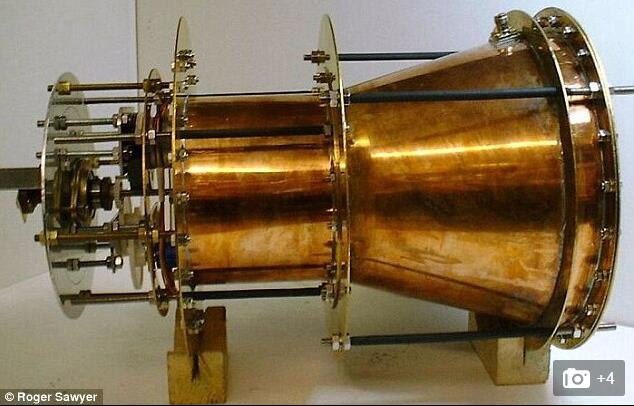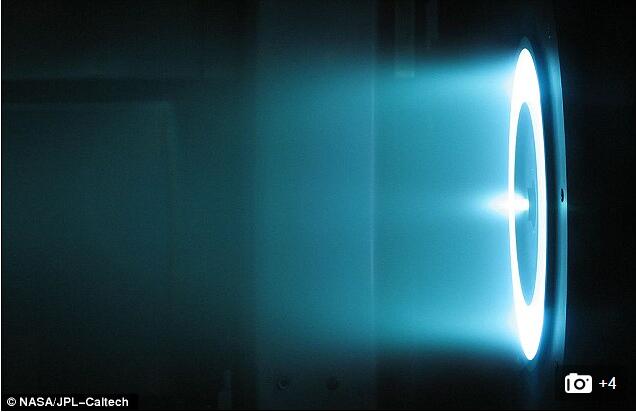

Scientists in China claim they’ve created a working prototype of the ‘impossible’ reactionless engine – and they say they’re already testing it in orbit aboard the Tiangong-2 space laboratory.
The radical, fuel-free EmDrive recently stirred up controversy after a paper published by a team of NASA researchers appeared to show they’d successfully built the technology.
If the physics-defying concept is brought to reality, it’s said the engine could get humans to Mars in just 10 weeks.
But now, scientists with the China Academy of Space Technology claim NASA’s results ‘re-confirm’ what they’d already achieved, and have plans to implement it in satellites ‘as quickly as possible.’

A fuel-free engine, described as 'impossible' to create, may now be a step closer to reality, according to leaked Nasa documents. Pictured is a prototype of the EMDrive
With no fuel to eject, the EmDrive would violate Newton’s third law, which states that for every action, there is an equal and opposite reaction.
At a press conference in Beijing, however, researchers with Cast confirmed the government has been funding research into the technology since 2010, and claimed they’ve developed a device that’s already being tested in low-Earth orbit, IBTimes UK reports.
It comes just a month after anonymous sources told IBTimes UK that tests on the EmDrive were underway aboard Tiangong-2.
‘National research institutions in recent years have carried out a series of long-term, repeated tests on the EmDrive,’ Dr Chen Yue, head of the communication satellite division at Cast said at the press conference, IBTimes UK reports.
‘NASA’s published test results can be said to re-confirm the technology. We have successfully developed several specifications of multiple prototype principles.

The NASA tests managed to generate powers of 1.2 millinewtons per kilowatt (mN/Kw), a fraction of the current state of the art Hall ion thruster, which can achieve a massive 60 mN/Kw (illustrated)
‘The establishment of an experimental verification platform to complete the milli-level micro thrust measurement test, as well as several years of repeated experiments and investigations into corresponding interference factors, confirm that in this type of thruster, thrust exists.’
Cast is a subsidiary of the Chinese Aerospace Science and Technology Corporation (CASC) and the manufacturer of Dong Fang Hong satellites.
According to Li Feng, chief designer of Cast’s communication satellite division, the team has built a prototype that so far generates just a few millinewtons of thrust, IBTimes UK reports.

 Who Will Fit The Chinese Roles In Game Of Thrones?
Who Will Fit The Chinese Roles In Game Of Thrones? China's Hubei Shennongjia added to World Heritage List
China's Hubei Shennongjia added to World Heritage List Cute Dog At Fruit Stand Becomes Latest Internet Sensation
Cute Dog At Fruit Stand Becomes Latest Internet Sensation Top 10 livable Chinese cities
Top 10 livable Chinese cities The last primitive tribe in China
The last primitive tribe in China China's first intelligent security robot debuts in Chongqing
China's first intelligent security robot debuts in Chongqing A Total of 3,552 Subscribers Vanish In Two Days; YouTube Closes All Doors to Users’ Inquiries
A Total of 3,552 Subscribers Vanish In Two Days; YouTube Closes All Doors to Users’ Inquiries Out of this world! Futuristic UFO-shaped yacht has its own garden and a stunning underwater viewing deck
Out of this world! Futuristic UFO-shaped yacht has its own garden and a stunning underwater viewing deck An old tea house in Chengdu
An old tea house in Chengdu Furious Customer Crushes All the Buns from Vendor Just Because He Was Given the Wrong Flavor
Furious Customer Crushes All the Buns from Vendor Just Because He Was Given the Wrong Flavor